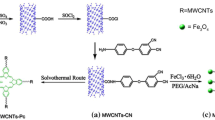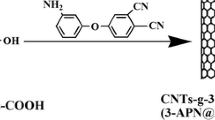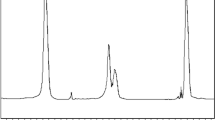Abstract
Electrically conductive multiwalled carbon nanotube (MWNT)/polyamide 6 (PA 6) nanocomposite films with high mechanical strength were fabricated by blending modified MWNTs with PA 6 polymer. The surface functionalization of MWNTs, which were modified using ureidopyrimidinone (upy) and pyrene-upy through covalent and noncovalent methods, respectively, significantly contributed to the uniform dispersion of MWNTs in PA 6, improving the electrical and mechanical properties of its nanocomposite. Particularly, noncovalent functionalization using pyrene-upy-MWNTs was more effective in achieving high electrical conductivities than covalent functionalization using upy-MWNTs. Pyrene-upy-MWNT/PA 6 nanocomposites with the highest electrical conductivity of 4.18 Scm−1, tensile strength of 39 MPa, and Young’s modulus of 911 MPa exhibited excellent electromagnetic interference (EMI) shielding effectiveness of 57.8 dB mm−1. These results suggest that the simple and effective preparation of MWNT/PA 6 nanocomposites using our noncovalent modification with pyrene-upy can provide benefits for application area required electrical conductivity and mechanical strength such as EMI shielding.
Graphical abstract








Similar content being viewed by others
References
Chen J, Liu B, Gao X, Xu D (2018) A review of the interfacial characteristics of polymer nanocomposites containing carbon nanotubes. RSC Adv 8:28048–28085
Kim JH, Hwang J-Y, Hwang HR, Kim HS, Lee JH, Seo J-W, Shin US, Lee S-H (2018) Simple and cost-effective method of highly conductive and elastic carbon nanotube/polydimethylsiloxane composite for wearable electronics. Sci Rep 8:1375
Li YM, Pang M, Feng S, Zhang J, Zhang C (2015) Effects of multi-walled carbon nanotube structures on the electrical and mechanical properties of silicone rubber filled with multi-walled carbon nanotubes. J Mater Chem C 3:5573–5579
Yang M, Weng L, Zhu H, Zhang F, Fan T, Zhang D (2017) Simultaneously improving the mechanical and electrical properties of poly(vinyl alcohol) composites by high-quality graphitic nanoribbons. Sci Rep 7:17137
Mohamed MG, Hsu K-C, Kuo S-W (2015) Bifunctional polybenzoxazine nanocomposites containing photo-crosslinkable coumarin units and pyrene units capable of dispersing single-walled carbon nanotubes. Polym Chem 6:2423–2433
Shih H-K, Hsieh C-C, Mohamed MG, Zhu C-Y, Kuo S-W (2016) Ternary polybenzoxazine/POSS/SWCNT hybrid nanocomposites stabilized through supramolecular interactions. Soft Mater 12:1847–1858
Mohamed MG, Kuo S-W (2019) Functional silica and carbon nanocomposites based on polybenzoxazines. Macromol Chem Phys 220:1800306
Samy MM, Mohamed MG, El-Mahdy AFM, Wu KC-W, Kuo S-W (2021) High-performance supercapacitor electrodes prepared from dispersions of tetrabenzonaphthalene-based conjugated microporous polymers and carbon nanotubes. ACS Appl Mater Interf 13:51906–51916
Cheng C-C, Wang Y-S, Chen J-K, Lee D-J (2016) Supramolecular electrospun nanofibers with high conductivity at ultra-low carbon nanotube content. J Mater Chem C 4:5207–5213
Jiang G, Song S, Zhai Y, Feng C, Zhang Y (2016) Improving the filler dispersion of polychloroprene/carboxylated multi-walled carbon nanotubes composites by non-covalent functionalization of carboxylated ionic liquid. Compos Sci Technol 123:171
Pramanik C, Gissinger JR, Kumar S, Heinz H (2017) Carbon nanotube dispersion in solvents and polymer solutions: mechanisms, assembly, and preferences. ACS Nano 11:12805–12816
Wang X, Xing W, Zhang P, Song L, Yang H, Hu Y (2012) Covalent functionalization of graphene with organosilane and its use as a reinforcement in epoxy composites. Compos Sci Technol 72:737–743
Bai L, Li Z, Zhao S, Zheng J (2018) Covalent functionalization of carbon nanotubes with hydroxyl-terminated polydimethylsiloxane to enhance filler dispersion, interfacial adhesion and performance of poly(methylphenylsiloxane) composites. Compos Sci Technol 165:274–281
Ryu J, Han M (2014) Improvement of the mechanical and electrical properties of polyamide 6 nanocomposites by non-covalent functionalization of multi-walled carbon nanotubes. Compos Sci Technol 102:169–175
Fujigaya T, Nakashima N (2015) Non-covalent polymer wrapping of carbon nanotubes and the role of wrapped polymers as functional dispersants. Sci Technol Adv Mater 16:024802
Maciejewska BM, Jasiurkowska-Delaporte M, Vasylenko AI, Kozio KK, Jurga S (2014) Experimental and theoretical studies on the mechanism for chemical oxidation of multiwalled carbon nanotubes. RSC Adv 4:28826–28831
Samy MM, Mohamed MG, Kuo S-W (2020) Pyrene-functionalized tetraphenylethylene polybenzoxazine for dispersing single-walled carbon nanotubes and energy storage. Compos Sci Technol 199:108360
Choi EY, Roh SC, Kim CK (2014) Noncovalent functionalization of multi-walled carbon nanotubes with pyrene-linked nylon66 for high performance nylon66/multi-walled carbon nanotube composites. Carbon 7:160–168
Kim KT, Jo WH (2010) Noncovalent functionalization of multiwalled carbon nanotubes using graft copolymer with naphthalene and its application as a reinforcing filler for poly(styrene-co-acrylonitrile). Polym Chem 48:4184–4191
Kim KT, Jo WH (2011) Non-destructive functionalization of multi-walled carbon nanotubes with naphthalene-containing polymer for nylon66/multi-walled carbon nanotube composites. Carbon 49:819–826
Li Z, Wang L, Li Y, Feng Y, Feng W (2019) Carbon-based functional nanomaterials: preparation, properties and applications. Compos Sci Technol 179:10–40
Zhou Y, Fang Y, Ramasamy RP (2019) Non-covalent functionalization of carbon nanotubes for electrochemical biosensor development. Sensors 19:392
Bhattacharya M (2016) Polymer nanocomposites: a comparison between carbon nanotubes, graphene, and clay as nanofillers. Mater 9:262
Kokil A, Saito T, Depolo W, Elkins CL, Wilkes GL, Long TE (2011) Introduction of multiple hydrogen bonding for enhanced mechanical performance of polymer-carbon nanotube composites. J Macromol Sci Pure Appl Chem 48:1016–1021
Yang L, Tan X, Wang Z, Zhang X (2015) Supramolecular polymers: historical development, preparation, characterization, and functions. Chem Rev 115:7196–7239
Yashima E, Ousaka N, Taura D, Shimomura K, Ikai T, Maeda K (2016) Supramolecular helical systems: helical assemblies of small molecules, foldamers, and polymers with chiral amplification and their functions. Chem Rev 116:13752–13990
Wang S, Guo H, Wang X, Wang Q, Li J, Wang X (2014) Self-assembled multiwalled carbon nanotube films assisted by ureidopyrimidinone-based multiple hydrogen bonds. Langmuir 30:12923–12931
Pochorovski I, Wang H, Feldblyum JI, Zhang X, Antaris AL, Bao Z (2015) H-bonded supramolecular polymer for the selective dispersion and subsequent release of large-diameter semiconducting single-walled carbon nanotubes. J Am Chem Soc 137:4328–4331
Wang Q, Wang S, Shang J, Qiu S, Zhang W, Wu X, Li J, Chen W, Wang X (2017) Enhanced electronic communication and electrochemical sensitivity benefiting from the cooperation of quadruple hydrogen bonding and π–π interactions in graphene/multi-walled carbon nanotube hybrids. ACS Appl Mater Interf 9:6255–6264
Lin F, Wang R, Liu L, Li B, Ouyang LW, Liu WJ (2017) Enhanced intermolecular forces in supramolecular polymer nanocomposites. Exp Polym Lett 11:690–703
Zhang Y, Tian W, Liu L, Cheng W, Wang W, Liew KM, Wang B, Hu Y (2019) Eco-friendly flame retardant and electromagnetic interference shielding cotton fabrics with multi-layered coatings. Chem Eng J 372:1077–1090
De Menezes BRC, Ferreira FV, Silva BC, Simonetti EAN, Bastos TM, Cividanes LS, Thim GP (2018) Effects of octadecylamine functionalization of carbon nanotubes on dispersion, polarity, and mechanical properties of CNT/HDPE nanocomposites. J Mater Sci 53:14311–14327
Sadri R, Hosseini M, Kazi SN, Bagheri S, Zubir N, Solangi KH, Zaharinie T (2017) Badarudin A (2017) A bio-based, facile approach for the preparation of covalently functionalized carbon nanotubes aqueous suspensions and their potential as heat transfer fluids. J Colloid Interface Sci 504:115–123
Li X, Zhao Z, Wang Y, Yan H, Zhang X (2017) Xu B (2017) Highly efficient flame retardant, flexible, and strong adhesive intumescent coating on polypropylene using hyperbranched polyamide. Chem Eng J 324:237–250
Doorn SK, O’connell MJ, Zheng L, Zhu YT, Huang S, Liu J (2005) Raman spectral imaging of a carbon nanotube intramolecular junction. Phys Rev Lett 94:016802
Zhang X, Zhang J, Quan J, Wang N, Zhu Y (2016) Surface-enhanced raman scattering activities of carbon nanotubes decorated with silver nanoparticles. Analyst 141:5527–5534
Vecera P, Chacón-Torres JC, Pichler T, Reich S, Soni HR, Görling A, Edelthalhammer K, Peterlik H, Hauke F, Hirsch A (2017) Precise determination of graphene functionalization by in situ raman spectroscopy. Nat Commun 8:15192
Jang PG, Suh KS, Park M, Kim JK, Kim WN (2007) Yoon HG (2007) Electrical behavior of polyurethane composites with acid treatment-induced damage to multiwalled carbon nanotubes. J Appl Polym Sci 106:110–116
Murphy H, Papakonstantinou P, Okpalugo TI (2006) Raman study of multiwalled carbon nanotubes functionalized with oxygen groups. J Vac Sci Technol 24:715–720
Sahebian S, Zebarjad SM, Vahdati KJ, Lazzeri AA (2015) Study on the dependence of structure of multi-walled carbon nanotubes on acid treatment. J Nanostruct Chem 5:287–293
Wepasnick KA, Smith BA, Schrote KE, Wilson HK, Diegelmann SR, Fairbroth DH (2011) Surface and structural characterization of multi-walled carbon nanotube following different oxidative treatments. Carbon 49:24–36
Hoseini AHA, Arjmand M, Sundararaj U, Trifkovic M (2017) Significance of interfacial interaction and agglomerates on electrical properties of polymer-carbon nanotube nanocomposites. Mater Des 125:126–134
Yang Y, Gupta MC, Dudley KL, Lawrence RW (2005) Novel carbon nanotube-polystyrene foam composites for electromagnetic interference shielding. Nano Lett 5:2131–2134
Kim H, Kim K, Lee CY (2004) Joo J (2004) Electrical conductivity and electromagnetic interference shielding of multiwalled carbon nanotube composites containing Fe catalyst. Appl Phys Lett 84:589–591
Acknowledgements
This research was supported by a grant from the KRICT Core Project, the R&D Convergence Program of the National Research Council of Science and Technology of the Republic of Korea, and the Creative Materials Discovery Program through the National Research Foundation of the Republic of Korea(NRF) funded by Ministry of Science and ICT(2020M3D1A1110505).
Author information
Authors and Affiliations
Corresponding author
Ethics declarations
Conflict of interest
The authors declare that they have no known competing financial interests or personal relationships that could have appeared to influence the work reported in this paper.
Additional information
Handling Editor: Gregory Rutledge.
Publisher's Note
Springer Nature remains neutral with regard to jurisdictional claims in published maps and institutional affiliations.
Rights and permissions
About this article
Cite this article
Jang, J., Kang, Y.H., Lim, HW. et al. Highly conductive and mechanically robust multiwalled carbon nanotube-polyamide nanocomposites via noncovalent functionalization. J Mater Sci 57, 4197–4209 (2022). https://doi.org/10.1007/s10853-022-06869-7
Received:
Accepted:
Published:
Issue Date:
DOI: https://doi.org/10.1007/s10853-022-06869-7




